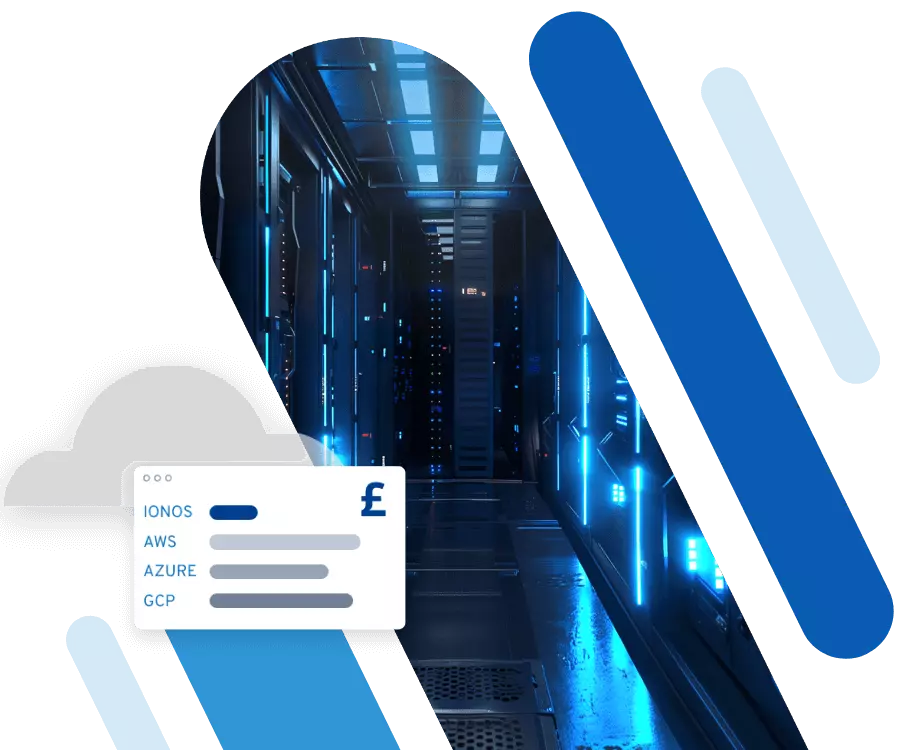What are GPU servers?
GPU servers offer huge computing capacities and allow for projects that wouldn’t be possible with traditional CPUs alone. Their ability to execute processes in parallel makes them well suited to many modern areas of application.
Manage any workload with flexible GPU computing power, and only pay for the resources you use.
What are GPU servers?
GPU servers are servers equipped with graphic processors (Graphic Processing Units or GPUs). GPUs were originally developed for graphic design, in particular for computer games and animation. However, it’s become clear in recent years that they can also be used for general computing tasks, thanks to their high performance. Their strengths are on full display when it comes to parallel calculations. While traditional servers use CPUs, which perform tasks sequentially, GPUs can execute several processes at once.
The main difference between CPUs and GPUs lies in their architecture and purpose. CPUs are optimised for general computing tasks and work sequentially, which makes them versatile but less efficient for parallel processes. On the other hand, GPUs are specially designed for the parallel processing of many small tasks. While a CPU has a few powerful cores, a GPU often has thousands of smaller cores that can work simultaneously.
What are the advantages of GPU servers?
Due to their architecture, GPU servers offer a number of advantages that set them apart from traditional CPU-based servers.
✓ High computing power for large amounts of data: GPUs are designed to process large amounts of data in parallel. That allows them to be very quick with tasks that would take traditional CPUs days or even weeks to process.
✓ Efficient with parallel tasks: Applications in the areas of machine learning and artificial intelligence, image and speech recognition, and simulations benefit immensely from the ability of GPUs to work on multiple processes simultaneously.
✓ More cost efficient with higher performance: While it might be more expensive to acquire a GPU server (depending on the exact hardware you want), it will quickly pay for itself with its faster processing times and the ability to complete several tasks at once.
✓ Scalability: GPU servers can easily be expanded to keep pace with your growing needs.
✓ Adaptability: GPU servers can be optimised for various requirements with frameworks and tools like TensorFlow and PyTorch.
Which areas are GPU servers used in?
GPU servers have a wide variety of applications. They are especially useful in areas that require high computing power and parallelisation. Some of the main areas of application for GPU servers are artificial intelligence and machine learning. The training processes for neural networks require enormous computing power that GPUs can easily provide.
GPU servers are also suitable for carrying out complex simulations in scientific fields like physics and biochemistry. Thanks to their numerous cores, GPUs can complete several small tasks at once and parallelise calculations. That makes GPU servers the tool of choice in high performance computing.
You’ll often hear talk of blockchain and cryptocurrency in connection with GPUs as well. That’s not surprising since mining and blockchain-based applications also benefit from the parallel architecture of GPUs.
And of course, GPUs are also a good choice for graphic processing. They’re indispensable for editing high-resolution videos, animation and virtual reality content. They speed up rendering processes and enable real-time editing.
What are the best high-performance GPU servers?
Choosing the right GPU is essential for getting the most out of your server. The current top models, which are also offered by hosting providers like IONOS, are setting new standards in performance. Comparing server GPUs, we can see that different models are suited to different areas of use:
- Nvidia H100: As one of the most powerful GPUs in the world, the Nvidia H100 is ideal for applications in AI and high performance computing. It has improved Tensor Cores that are specifically optimised for machine learning and AI training. Its energy efficiency and scalability make it an excellent choice for companies that need maximum performance.
- Nvidia A100: The Nvidia A100 supports faster training and inferences for AI models. With its third-generation Tensor Cores, it offers exceptional performance for tasks in deep learning and high performance computing.
- Nvidia A30: The Nvidia A30 combines computing power with efficiency. It’s especially suited for workloads that include both training and inference tasks, such as AI-assisted analysis and cloud services.
- Intel Gaudi 3: This GPU was specifically developed for AI and machine learning. With architecture designed for low energy consumption and high scalability, it’s an alternative to Nvidia GPUs and is optimised for specific AI frameworks.
At IONOS, you’ll find a selection of powerful GPU servers. Pay-per-minute billing ensures that you only pay for the resources you actually need.

